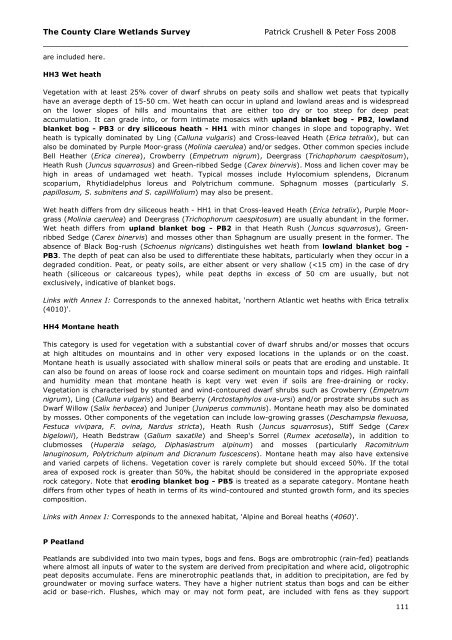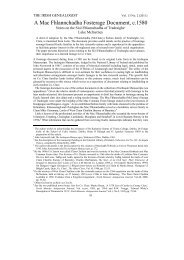Report Cover Vol I - Clare County Library
Report Cover Vol I - Clare County Library
Report Cover Vol I - Clare County Library
You also want an ePaper? Increase the reach of your titles
YUMPU automatically turns print PDFs into web optimized ePapers that Google loves.
The <strong>County</strong> <strong>Clare</strong> Wetlands Survey Patrick Crushell & Peter Foss 2008<br />
_______________________________________________________________<br />
are included here.<br />
HH3 Wet heath<br />
Vegetation with at least 25% cover of dwarf shrubs on peaty soils and shallow wet peats that typically<br />
have an average depth of 15-50 cm. Wet heath can occur in upland and lowland areas and is widespread<br />
on the lower slopes of hills and mountains that are either too dry or too steep for deep peat<br />
accumulation. It can grade into, or form intimate mosaics with upland blanket bog - PB2, lowland<br />
blanket bog - PB3 or dry siliceous heath - HH1 with minor changes in slope and topography. Wet<br />
heath is typically dominated by Ling (Calluna vulgaris) and Cross-leaved Heath (Erica tetralix), but can<br />
also be dominated by Purple Moor-grass (Molinia caerulea) and/or sedges. Other common species include<br />
Bell Heather (Erica cinerea), Crowberry (Empetrum nigrum), Deergrass (Trichophorum caespitosum),<br />
Heath Rush (Juncus squarrosus) and Green-ribbed Sedge (Carex binervis). Moss and lichen cover may be<br />
high in areas of undamaged wet heath. Typical mosses include Hylocomium splendens, Dicranum<br />
scoparium, Rhytidiadelphus loreus and Polytrichum commune. Sphagnum mosses (particularly S.<br />
papillosum, S. subnitens and S. capillifolium) may also be present.<br />
Wet heath differs from dry siliceous heath - HH1 in that Cross-leaved Heath (Erica tetralix), Purple Moorgrass<br />
(Molinia caerulea) and Deergrass (Trichophorum caespitosum) are usually abundant in the former.<br />
Wet heath differs from upland blanket bog - PB2 in that Heath Rush (Juncus squarrosus), Greenribbed<br />
Sedge (Carex binervis) and mosses other than Sphagnum are usually present in the former. The<br />
absence of Black Bog-rush (Schoenus nigricans) distinguishes wet heath from lowland blanket bog -<br />
PB3. The depth of peat can also be used to differentiate these habitats, particularly when they occur in a<br />
degraded condition. Peat, or peaty soils, are either absent or very shallow (
















